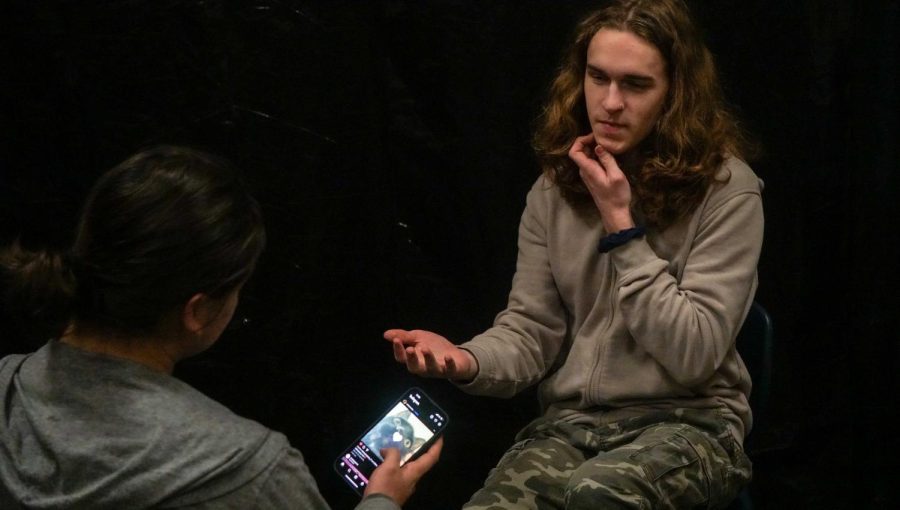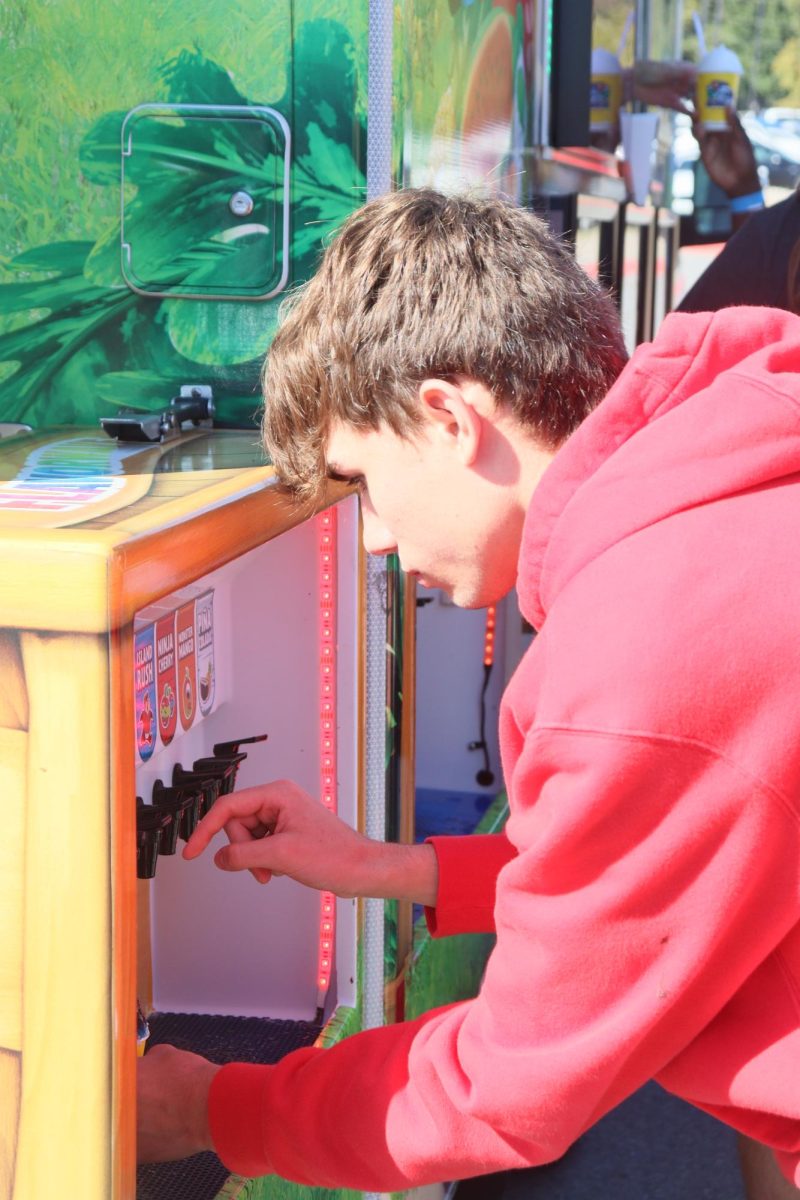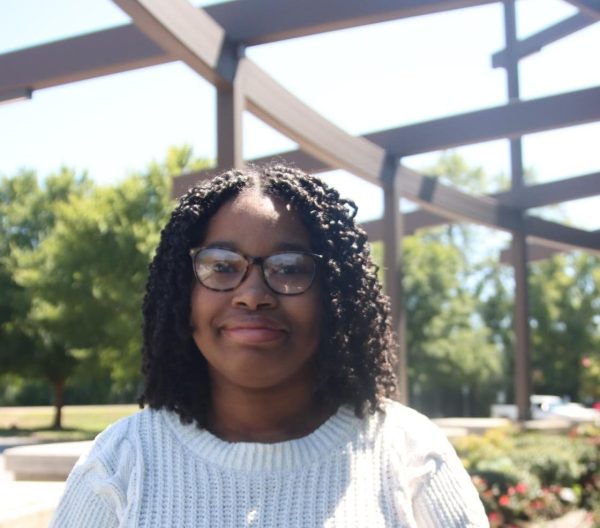Dangerous Discussions
Bryant psychology teacher explores the adverse effects of pop culture on upcoming young adults
Student Preston Gibson speaks with distracted student Angel Santana.
April 14, 2022
The romanticization of drug use, toxic relationships, and self deprecation are seen repetitively throughout social media, movies, shows, and in the everyday life of teens. Trends that depict an attractive image behind drug use and toxic relationships, influence the way in which teenagers create their image. John Watson, Psychology teacher, has had a front row seat as his students consume the culture around them.
“I’m not someone who wants to vilify social media, but I can see the dangerous trends, especially with Tik Tok,” Watson said. “I see kids just staring at it, but I also see them trying to emulate it and then they’re also trying to get the clout from it so I can see where the dangerous part of it is.”
Watson describes the influence social media has on students, and the effects it has on them in and out of the classroom.
“Social media has caused such a huge spike in anxiety for this generation especially,” Watson said. “Maybe it went undiagnosed in earlier generations because people didn’t know what it was but there’s a huge amount of students you see that are diagnosed with anxiety and I think a lot of that can directly be tied back to social media use and trying to fit in with what you see there which is not really real in a lot of ways.”
Euphoria, a popular show on HBO Max, highlights teens who carry different types of addiction that gives them a false sense of happiness such as drugs, alcohol, and validation. The toxicity of the relationships between the characters, as well as the abuse of drugs, are a reflection of how media and television can directly affect its audience.
“Even kids that aren’t on drugs it almost at times feels like they’re trying to make people feel like they are or trying to put out that image,” Watson said.
With students growing into a digital society, it is easier to learn more than before at a faster rate. Social media allows people to connect with each other without being physically present and to view the lives of others by scrolling through their feed.
“Everybody wants to fit in, and that’s just basic psychology,” Watson said. “Everybody wants to be a part of something, the old expression was, “the nail that sticks up gets hammered down.”
Watson believes that the rise in depression and anxiety can be linked to the overuse of social media today, and that in his generation similar behaviors were shared.
“In my generation you watched MTV and wanted to be like those kids,”Watson said. “Now it’s social media and you want to emulate what you see there, but you can see in the 90’s there was something called heroin chique. (It was) Where every girl stopped eating because they wanted to look like they were on heroin because the supermodel was, so it’s not a new phenomenon.”
Toxic relationships are romanticized by youth as the media portrays them as adventurous, rebellious, consisting of happy endings as well as creating a conventionally attractiveness to villain characters. In the love story of Harley Quinn and the Joker, we see a toxic relationship unravel between two villains and the masses romanticize this theatrical relationship. Watson believes the behaviors and images students build corresponds to the constant flow of trends and what is deemed as socially acceptable at the time.
“I had to put a stop to the Tik Tok videos being recorded in my classroom because I was like you guys just keep doing the same thing over and over other people have done come up with something original and they were like that’s not how this works,” Watson said. “I think that part of it is whatever the trend is of the day, let’s be that.”
Watson feels that the trendiness of drugs and false emulation is dangerous and could lead to much worse.
“I can definitely see the dangers of that,” Watson said. “Drugs in and of themselves are dangerous but when you don’t understand them they become even more dangerous. It’s like why the addict goes to rehab and ends up overdosing when they get out because they can’t do the same amount they did before they went.”
Watson believes social media has made it easier to succumb to addictions and romanticize them.
“Social media makes everything so much bigger because it’s so readily accessible and everybody has smartphones with apps that let them watch what they want,” Watson said.
Watson feels that social media has enabled society to say what they want, even if it hurts others.
“You see these things on social media and it’s like we don’t know how to deal with our emotions anymore,” Watson said. “They used to make the joke that people have gotten way too comfortable with not getting punched in the mouth for saying things and then for a year of us being apart from each other it got worse.”
As Watson sees how his students’ inner turmoils affect them, he acknowledges the importance of raw communication, connection, and what they find to be significant.
“Because we have so many interactions that aren’t face to face, it slows our ability to deal with those emotions in a lot of ways,” Watson said. “I think because you see so many people on TV and in the media that aren’t dealing with them well, it’s something that’s glorified. Nobody’s going to watch the Kardashians if it’s not drama, that’s what half of your television shows are now, people who can’t deal with each other.”
While the entertainment and media is out of our youth’s control, how youth communicate with each other and express themselves is. Watson believes that communication is a key factor in correcting misinterpretations in the media that glorifies toxic traits.
“I think we’ve lost sight of the old saying that if you don’t have anything nice to say don’t say anything at all,” Watson said. “Just because you have the right to say something doesn’t mean you should, and you see so much of it that you think it’s okay to do it yourself with the normalization of bad behavior.”








